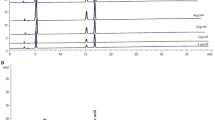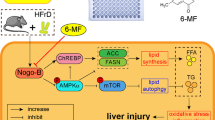Abstract
Objective:
To determine whether proanthocyanidins can protect against dyslipidemia induced by a high-fat diet (HFD) and to address the mechanisms that underlie this hypolipidemic effect.
Design and measurements:
Female Wistar rats were fed on a HFD for 13 weeks. They were divided into two groups, one of which was treated with a grape seed proanthocyanidin extract (25 mg kg−1 of body weight) for 10 days. Plasma and liver lipids were measured by colorimetric and gravimetric analysis. Liver, muscle and adipose tissue were used to study the expression of genes involved in the synthesis and oxidation of fatty acids and lipoprotein homeostasis by real-time RT-PCR.
Results:
The administration of proanthocyanidins normalized plasma triglyceride and LDL-cholesterol (both parameters significantly increased with the HFD) but tended to decrease hypercholesterolemia and fatty liver. Gene expression analyses revealed that proanthocyanidins repressed both the expression of hepatic key regulators of lipogenesis and very low density lipoprotein (VLDL) assembling such as SREBP1, MTP and DGAT2, all of which were overexpressed by the HFD.
Conclusion:
These findings indicate that natural proanthocyanidins improve dyslipidemia associated with HFDs, mainly by repressing lipogenesis and VLDL assembly in the liver, and support the idea that they are powerful agents for preventing and treating lipid altered metabolic states.
This is a preview of subscription content, access via your institution
Access options
Subscribe to this journal
Receive 12 print issues and online access
$259.00 per year
only $21.58 per issue
Buy this article
- Purchase on Springer Link
- Instant access to full article PDF
Prices may be subject to local taxes which are calculated during checkout
Similar content being viewed by others
References
Hokanson JE . Hypertriglyceridemia and risk of coronary heart disease. Curr Cardiol Rep 2002; 4: 488–493.
Yuan G, Al-Shali KZ, Hegele RA . Hypertriglyceridemia: its etiology, effects and treatment. CMAJ 2007; 176: 1113–1120.
Riches FM, Watts GF, Naoumova RP, Kelly JM, Croft KD, Thompson GR . Hepatic secretion of very-low-density lipoprotein apolipoprotein B-100 studied with a stable isotope technique in men with visceral obesity. Int J Obes Relat Metab Disord 1998; 22: 414–423.
Ginsberg HN, Zhang YL, Hernandez-Ono A . Regulation of plasma triglycerides in insulin resistance and diabetes. Arch Med Res 2005; 36: 232–240.
Nesto RW . Beyond low-density lipoprotein: addressing the atherogenic lipid triad in type 2 diabetes mellitus and the metabolic syndrome. Am J Cardiovasc Drugs 2005; 5: 379–387.
Watts GF, Herrmann S, Riches FM . Effects of diet and serotonergic agonist on hepatic apolipoprotein B-100 secretion and endothelial function in obese men. QJM 2000; 93: 153–161.
Prior RL, Gu L . Occurrence and biological significance of proanthocyanidins in the American diet. Phytochemistry 2005; 66: 2264–2280.
Aron P, Kennedy J . Flavan-3-ols: nature, occurrence and biological activity. Mol Nutr Food Res 2008; 52: 79–104.
Bagchi D, Sen CK, Ray SD, Das DK, Bagchi M, Preuss HG et al. Molecular mechanisms of cardioprotection by a novel grape seed proanthocyanidin extract. Mutat Res 2003; 523-524: 87–97.
Auger C, Gerain P, Laurent-Bichon F, Portet K, Bornet A, Caporiccio B et al. Phenolics from commercialized grape extracts prevent early atherosclerotic lesions in hamsters by mechanisms other than antioxidant effect. J Agric Food Chem 2004; 52: 5297–5302.
Kar P, Laight D, Shaw KM, Cummings MH . Flavonoid-rich grapeseed extracts: a new approach in high cardiovascular risk patients? Int J Clin Pract 2006; 60: 1484–1492.
Del Bas JM, Fernández-Larrea J, Blay M, Ardévol A, Salvadó MJ, Arola L et al. Grape seed procyanidins improve atherosclerotic risk index and induce liver CYP7A1 and SHP expression in healthy rats. FASEB J 2005; 19: 479–481.
Zern TL, Wood RJ, Greene C, West KL, Liu Y, Aggarwal D et al. Grape polyphenols exert a cardioprotective effect in pre- and postmenopausal women by lowering plasma lipids and reducing oxidative stress. J Nutr 2005; 135: 1911–1917.
Castilla P, Echarri R, Davalos A, Cerrato F, Ortega H, Teruel JL et al. Concentrated red grape juice exerts antioxidant, hypolipidemic, and antiinflammatory effects in both hemodialysis patients and healthy subjects. Am J Clin Nutr 2006; 84: 252–262.
Del Bas JM, Ricketts M, Baiges I, Quesada H, Ardévol A, Salvadó MJ et al. Dietary procyanidins lower triglyceride levels signaling through the nuclear receptor small heterodimer partner. Mol Nutr Food Res 2008; 52: 1172–1181.
Puigserver P, Llado I, Palou A, Gianotti M . Evidence for masking of brown adipose tissue mitochondrial GDP-binding sites in response to fasting in rats made obese by dietary manipulation. Effects of reversion to standard diet. Biochem J 1991; 279: 575–579.
Draeger B, Wahlefeld AW, Ziegenhornvol J . HDL-cholesterol. In: Bergmeyer, H.U., (ed) Methods of Enzymatic Analysis. Academic Press: New York, 1985, pp 148–154.
Kerscher L, Draeger B, Maier J, Ziegenhorn J . LDL-cholesterol. In: Bergmeyer, H.U., (ed) Methods of Enzymatic Analysis. Academic Press: New York, 1985, pp 154–160.
Folch J, Lees M, Stanley G . A simple method for the isolation and purification of total lipids from animal tissues. J Biol Chem 1957; 226: 497–509.
Bamba V, Rader DJ . Obesity and atherogenic dyslipidemia. Gastroenterology 2007; 132: 2181–2190.
Rothwell NJ, Stock MJ . The cafeteria diet as a tool for studies of thermogenesis. J Nutr 1988; 118: 925–928.
Ferre P, Foufelle F . SREBP-1c transcription factor and lipid homeostasis: clinical perspective. Horm Res 2007; 68: 72–82.
Gibbons GF, Wiggins D, Brown AM, Hebbachi AM . Synthesis and function of hepatic very-low-density lipoprotein. Biochem Soc Trans 2004; 32: 59–64.
Ramsay RR, Gandour RD, van der Leij FR . Molecular enzymology of carnitine transfer and transport. Biochim Biophys Acta 2001; 1546: 21–43.
Watanabe M, Houten SM, Wang L, Moschetta A, Mangelsdorf DJ, Heyman RA et al. Bile acids lower triglyceride levels via a pathway involving FXR, SHP, and SREBP-1c. J Clin Invest 2004; 113: 1408–1418.
Bavner A, Sanyal S, Gustafsson JA, Treuter E . Transcriptional corepression by SHP: molecular mechanisms and physiological consequences. Trends Endocrinol Metab 2005; 16: 478–488.
Acknowledgements
This study was supported by Grant number AGL2008-00387 from the Spanish Dirección General de Investigación del Ministerio de Educación y Ciéncia. L Arola is a member of MITOFOOD.
Author information
Authors and Affiliations
Corresponding author
Rights and permissions
About this article
Cite this article
Quesada, H., del Bas, J., Pajuelo, D. et al. Grape seed proanthocyanidins correct dyslipidemia associated with a high-fat diet in rats and repress genes controlling lipogenesis and VLDL assembling in liver. Int J Obes 33, 1007–1012 (2009). https://doi.org/10.1038/ijo.2009.136
Received:
Revised:
Accepted:
Published:
Issue Date:
DOI: https://doi.org/10.1038/ijo.2009.136
Keywords
This article is cited by
-
Co-treatment with grape seed extract and mesenchymal stem cells in vivo regenerated beta cells of islets of Langerhans in pancreas of type I-induced diabetic rats
Stem Cell Research & Therapy (2022)
-
Peanut (Arachis hypogaea) sprout prevents high-fat diet-induced cognitive impairment by improving mitochondrial function
Scientific Reports (2022)
-
Cynandione A from Cynanchum wilfordii inhibits hepatic de novo lipogenesis by activating the LKB1/AMPK pathway in HepG2 cells
Journal of Natural Medicines (2020)
-
Effect of oral cinnamon intervention on metabolic profile and body composition of Asian Indians with metabolic syndrome: a randomized double -blind control trial
Lipids in Health and Disease (2017)
-
Grape seed proanthocyanidin supplementation reduces adipocyte size and increases adipocyte number in obese rats
International Journal of Obesity (2017)



